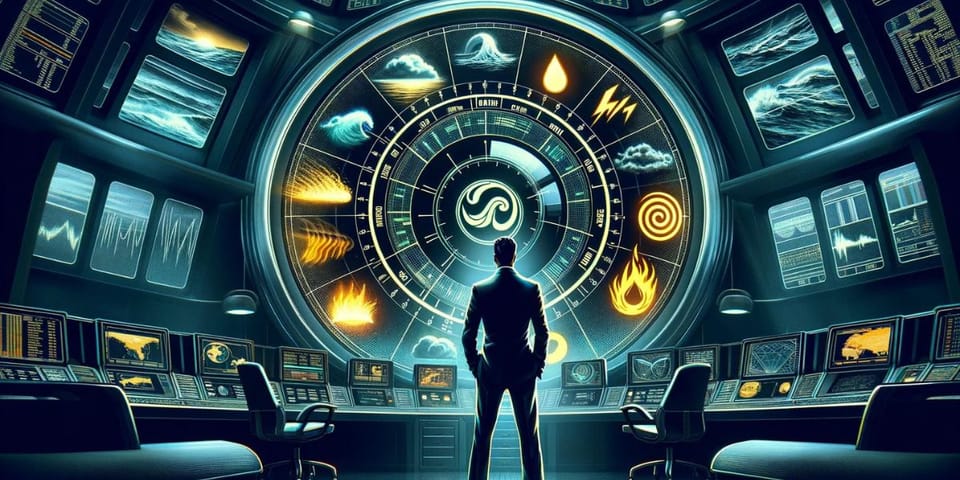No, climate scenarios are not 'malarkey'

You don’t hear the whistle of the bullet that hits you. Scenario analysis is a tool used to try and disprove this aphorism. Regulators and risk managers use ‘what if?’ scenarios to test the resilience of financial institutions to an array of threats of varying plausibility and severity and identify any weak spots.
As the specter of climate change has grown more ominous, institutions of all shapes and sizes have turned to scenario analysis to estimate just how nasty things could get for the financial system if we don’t stop slowly boiling ourselves – or in trying to, end up unleashing other risks.
Tony and I both have our beef with using scenario analysis in this way, but our complaints differ in degree and in kind. In this post I’m going to butt against Tony’s criticisms, leaving my own issues with climate scenario analysis for a future rant. For now, suffice to say that I believe the “mainstream” climate scenario analyses conducted by central banks (and in-house at some climate-forward institutions) use the wrong tools and focus on the wrong time horizons. However, I maintain that climate scenario analysis in and of itself is a worthy enterprise and a valuable risk management tool.
Why? Because I (and plenty of climate scientists) believe we are entering an unprecedented new age – the Late Anthropocene, if you will. This age will be characterized by volatility, uncertainty, complexity, and ambiguity (VUCA) several orders of magnitude greater than what we’ve been familiar with to date, thanks to the growing impacts of (and attempted responses to) climate change. It’ll be an age where climate physical and transition impacts interact in scary new ways, giving rise to “compound risks” and nonlinear effects that can’t be inferred from the historical record.
A collective desperation to avoid this epochal shift is the very reason why the Paris Climate Agreement hardcoded the 1.5°C and “well below 2°C” temperature rise limits in black and white. The science shows that breaching 1.5°C risks unleashing far more severe climate change impacts than what we’ve seen before, including more frequent and severe droughts, heatwaves and rainfall. As the Intergovernmental Panel on Climate Change (IPCC) explains, climate risks “to health, livelihoods, food security, water supply, human security, and economic growth” are predicted to surge past 1.5°C and increase further beyond 2°C.
Put simply, the science suggests that the world will be very, perhaps unknowably, different if and when average temperatures pass these thresholds. This being the case, scenario analysis – the positing of “untestable assertions about an uncertain future” – is a risk management tool as good as any other. There just isn’t reliable historical data we can draw upon to paint a picture of how nature, society, and finance will behave in this new world.
This is not to say that climate scenarios are pure fantasies, untethered from empiricism. Hard data serves as the launchpad for most climate scenarios, after all. Take a look at the Federal Reserve’s climate scenario analysis exercise, for example. The physical and transition risk modules ask participants to estimate their vulnerability to shocks that could occur under various warming pathways developed by the IPCC. The Representative Concentration Pathways (RCPs) and Shared Socioeconomic Pathways (SSPs) cited by the Fed tell plausible stories of our future based on mountains of historical data, covering population, economic development, education, urbanization, and technology, among many others.
In other words, climate scenario analyses use historical data as a starting point, but do not pretend that past performance will be indicative of future results.
From this viewpoint, Tony’s challenge is impossible. We cannot show that past predictions missed critical features that render them invalid, because those features are currently unobservable. We don’t know what climatic and socioeconomic factors will be churned up if and when the world breaches 1.5°C or 2°C of warming. And we shouldn’t want to find out! All we get from the available science is that these factors are likely to be of a wholly different character from those we’ve seen before.
By the way, we already have some signs that the world is entering a new phase of warming. This past September’s record-breaking temperatures were “absolutely gobsmacking bananas”, according to one climate scientist, beating the long term recent average by almost a whole degree. In addition, some scientists argue that the climate may change at a faster rate in the near future.
Furthermore, does it actually matter that these scenarios can’t be refuted? If the purpose of climate scenario analysis is to build resilience to climate risks in whatever form they come in, then the fact that the scenarios themselves don’t come to pass is irrelevant. As long as the analysis somehow better prepares financial institutions for the physical and transition shocks that do occur, the exercise is worth it. (And yes, there are limits to this, particularly if the climate scenario exercises are too complicated, expensive, and ill-focused).
While for now current temperature extremes are within the range of what climate models predicted and the financial system has proven resilient to them, research on global tipping points suggests that certain natural systems may shift to entirely new states beyond certain temperature limits, with profound consequences for nature and human societies. And of course, the sensitivity of economic and financial systems to each fraction of a degree of warming is likely to increase over time as the resulting impacts become more severe. To bastardize financial lingo, our “climate delta” is in an unpredictable state of flux.
In anticipation of a high VUCA world, it makes sense for financial institutions and their regulators to listen out for the whistles of the many, many bullets that may come their way. Climate scenario analysis is as good a pair of ears as any for this task.
Let’s keep listening.
Member discussion